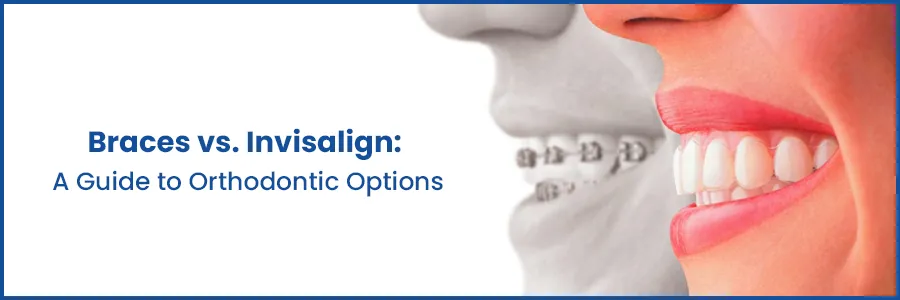
Braces vs. Invisalign: Comparing Orthodontic Options for a Perfect Smile
If you're considering orthodontic treatment to achieve a straighter smile, you might have encountered two popular options: braces and Invisalign. Both are effective at correcting teeth misalignments but differ in various aspects. In this guide, we will compare braces and Invisalign, discussing their differences, benefits, and considerations to help you make an informed decision for your orthodontic journey.
Braces: The Time-Tested Traditional Approach
How Braces Work: Braces are metal or ceramic brackets attached to the teeth and connected with wires and elastic bands. This fixed appliance applies consistent pressure to gradually guide teeth into their desired positions. The orthodontist adjusts the braces periodically to ensure progress.
Benefits of Braces:
- Versatility: Braces effectively correct dental issues, from simple to complex cases, including overcrowding, misaligned bites, and severe alignment problems.
- Predictable Results: Braces' controlled and precise nature allows for predictable outcomes in aligning teeth.
- Appearance: Braces are visible due to the metal or ceramic components, which may impact your aesthetic preferences.
Secure your health with a second opinion. Make informed decisions and book your appointment today!
Get A Second OpinionInvisalign: The Discreet and Removable Option
- How Invisalign Works:Invisalign employs a series of clear, custom-made aligners crafted from smooth plastic. These aligners fit snugly over the teeth and apply gentle pressure to shift them gradually into alignment. The aligners are removable, allowing for easy oral hygiene and the freedom to eat and drink without restrictions.
- Benefits of Invisalign:Discreet Appearance: Invisalign aligners are virtually invisible when worn, making them appealing to those seeking a more discreet treatment option.
- Removability: The ability to remove the aligners means you can enjoy your favourite foods and maintain oral hygiene more effectively.
- Considerations for Invisalign:Treatment Suitability: Invisalign is best suited for mild to moderate dental misalignments. Complex cases may require braces for more precise control.
- The Complexity of Your Case: Consult with an orthodontist to assess the complexity of your dental issues. Braces might be more suitable for intricate cases, while Invisalign is ideal for mild to moderate misalignments.
- Lifestyle and Aesthetics: Consider your lifestyle and aesthetic preferences. If you prefer a nearly invisible treatment that allows you to remove aligners when needed, Invisalign may be the right choice.
- Treatment Compliance: Success with Invisalign depends on wearing the aligners for the recommended duration each day. Ensure you can comply with the treatment requirements for optimal results.
Choosing Between Braces and Invisalign:
Conclusion
Braces and Invisalign are two powerful contenders in orthodontic options, each offering unique advantages for achieving a perfect smile. With their time-tested approach, braces are a versatile and practical choice capable of addressing a wide range of dental misalignments, making them a reliable option for complex cases. On the other hand, Invisalign presents a discreet and convenient alternative, allowing wearers to experience the journey to straighter teeth without the appearance of traditional braces.
When considering braces or Invisalign, assessing your dental needs, lifestyle, and aesthetic preferences is essential. Braces may be the ideal choice for those seeking predictability and a reliable solution for more intricate dental issues. On the contrary, individuals desiring a virtually invisible option that affords them flexibility in daily activities might find Invisalign the perfect fit.
Consulting with an experienced orthodontist is paramount in making an informed decision that aligns with your unique goals for achieving a confident and beautiful smile. Remember, braces, and Invisalign can yield exceptional results under the guidance of a skilled professional, transforming your smile and enhancing your overall oral health.
Whether you choose braces or Invisalign, the journey to a straighter smile is an investment in your well-being and self-confidence. Embrace the transformation, and let your orthodontic adventure lead you to the radiant smile you've always dreamed of.
Ready to take control of your health journey? Book your appointment now and start your path towards wellness today!
Book an AppointmentFrequently Asked Questions
Both braces and Invisalign are effective in correcting dental misalignments. Mounts are more versatile and can handle complex cases, while Invisalign is ideal for mild to moderate misalignments.
Braces are visible due to the metal or ceramic brackets and wires. In contrast, Invisalign aligners are virtually invisible when worn, making them a more discreet option.
Invisalign aligners are generally considered more comfortable since they lack brackets and wires that might irritate the cheeks and lips.
Braces and Invisalign should not significantly interfere with playing musical instruments or participating in sports. However, athletes may require a mouthguard while wearing braces for added protection.
Braces and Invisalign are suitable for adults seeking orthodontic treatment to correct dental misalignments and achieve a straighter smile.
With braces, avoiding sticky and hard foods that might damage the brackets is recommended. Invisalign allows you to remove the aligners while eating, so there are no dietary restrictions.
Orthodontic coverage varies based on insurance plans. It's advisable to check with your insurance provider to determine the extent of coverage for braces or Invisalign treatment.
The decision between braces and Invisalign depends on factors such as the complexity of your dental issues, personal preferences, and lifestyle considerations. Consult with an orthodontist for a tailored recommendation based on your specific needs.
Switching from braces to Invisalign or vice versa is generally not recommended. Each treatment is designed to work with specific dental conditions, and a change midway could affect the progress and desired results.
Good oral hygiene is essential during orthodontic treatment. Regularly brush and floss your teeth and clean your braces or Invisalign aligners as instructed by your orthodontist.

Categories
- Cardiology 84
- Dermatology 45
- Endocrinology 33
- ENT 16
- Fertility 190
- Gastroenterology 78
- General-Medicine 81
- General 6
- Gynecology 80
- Hematology 19
- Infectious-Diseases 33
- Neurology 52
- Oncology 34
- Ophthalmology 23
- Orthopedics 69
- Pediatrics 31
- Procedure 23
- Public-Health 144
- Pulmonology 59
- Radiology 8
- Urology 68
- Wellness 161
- Woman-and-child 77